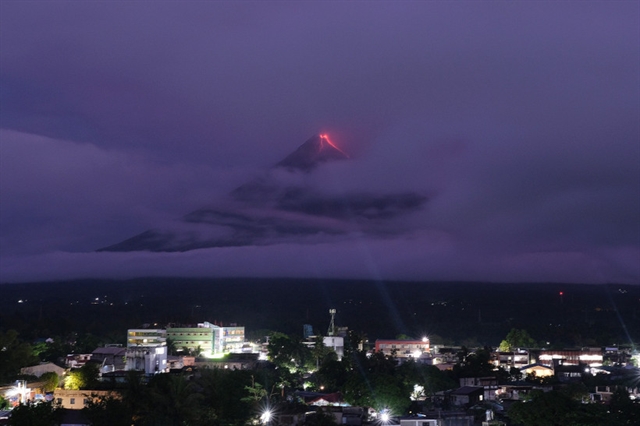 Features
Features

Đà Nẵng’s amazing transformation from an abandoned US military station in 1975 to the most liveable city in the country hosting the APEC 2017 summit is a story that goes back centuries, writes Bùi Hoài Nam.
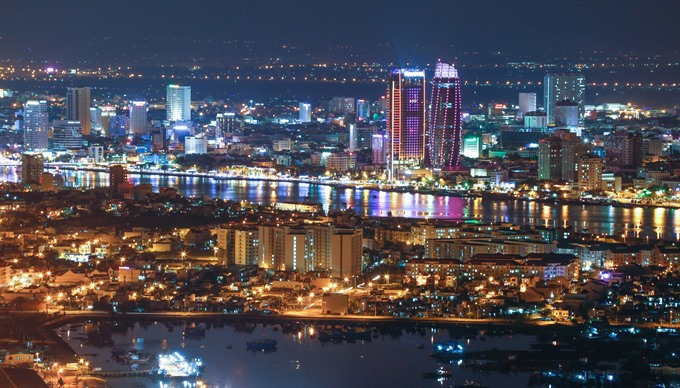 |
| Strategic: The Hàn River lights up at night. Cruise boats sail the river every night.— VNS Photos Trần Lê Lâm |
Đà Nẵng’s amazing transformation from an abandoned US military station in 1975 to the most liveable city in the country hosting the APEC 2017 summit is a story that goes back centuries, writes Bùi Hoài Nam.
Vietnamese-French artist Vũ Trọng Thuấn has been around, seen the world.
After living for 32 years in France, the Hai Phong native decided to return to Viet Nam in 1999. He spent five years in HCM City, where he grew up as a child, and seven years in Ha Noi.
But after a visit to Da Nang, he decided that he would spend the rest of his life in the central city. He bought a house and opened a gallery, the La Tour Eiffel Studio, on the banks of the Hàn River.
Thuan, 77, works on lacquer, but uses styrofoam “creatively” instead of wood.
“I was struck by the hospitality and friendliness of people as I first walked on the streets of Đà Nẵng. I was a stranger, but people were very helpful, even if they were busy doing something else.
“I decided to retire here. My house and gallery are a rendezvous for new friends in the city, and my wish is to give all my art treasures to the younger generation, including my work.”
The artist is one of hundreds of thousands of people who’ve moved here or invested in holiday or retirement homes.
The central city’s emergence as the most well developed urbanized location in the country is a remarkable story of rising from the ashes of the American War. The place where US combat troops landed first, it was an abandoned US military station when the war ended in 1975.
Today, the city stands at a political and socioeconomic junction of great strategic significance. Situated at the east end of the East-West Economic Corridor linking Laos, Thailand, Myanmar and Việt Nam, the city is set to be a cultural, trade and investment hub in central Viet Nam as well as the Association of Southeast Asian Nations (ASEAN).
After the country’s reunification in 1975, a merger formed the Quảng Nam-Đà Nẵng province, but in 1997 they were separated into Đà Nẵng City and Quảng Nam Province, with the former becoming one of the five centrally-administered cities alongside Ha Noi, HCM City, Can Tho and Hai Phong.
New port, centuries ago
Đà Nẵng, located near the Hàn River Estuary, emerged as a new port in the late18th and early 19th centuries after the then major trading port of Hội An began to silt up between the 15th and 18th centuries.
The city still preserves the Điện Hải Citadel, built as a military outpost in 1813 during King Gia Long’s reign near the mouth of the Hàn River. It controlled access to Đà Nẵng port and served as an important defence position. The citadel still has a moat and several cannons.
 |
| Big divide: The Hải Vân Gate sits on the top of the Hải Vân Pass in Đà Nẵng. The gate borders Thừa Thiên-Huế and Đà Nẵng City. — VNS Photo Công Thành |
A collection of 11 cannons, cast between 1802 and 1860, were unearthed at the Điện Hải Citadel between 1979 and 2008. They are linked to Nguyễn Tri Phương (1800-1873), a famous general who commanded an army fighting French-Spanish coalition forces in 1858-60.
The Hải Vân Gate, situated on the top of the Hải Vân Pass, is a complex of brick-built control towers dating back to the 13th century, and octagonal bunkers from the French colonial period. It was once the border between Đại Việt (the Great Việt, now Việt Nam) and the Champa Kingdom, which ruled the central region between the fourth and 13th centuries.
In the 15th century under the reign of King Lê Thánh Tông, the region of Quảng Nam stretched from Hải Vân Pass in Đà Nẵng to what is now Phú Yên Province. It then narrowed from the pass to Dốc Sỏi in Núi Thành District (Quảng Nam Province), and Đà Nẵng became an entrance to Quảng Nam from the Hải Vân Pass during the reign of King Minh Mạng of the Nguyễn Dynasty in 1832.
The Hai Van Pass, which was part of the two provinces of Ô (Quảng Trị province now) and Lý (Thừa Thiên-Huế), became part of the Great Việt after Champa King Jaya Sinhavarman III presented them to Great Việt as his wedding gift when he married Princess Huyền Trân, daughter of King Trần Nhân Tông.
Archaeologist Phạm Văn Triệu of the Việt Nam Archaeology Institute said Đà Nẵng was an intersection of different layers of cultures dating back at least 3,000 years.
He said stone tools and ceramic pieces found from excavations in Đà Nẵng showed that the pre-Sa Huỳnh Culture had existed in the city, and that there were exchanges between people from Đại Việt (Great Việt, or now Việt Nam) and people in the Champa Kingdom.
Many Chăm tower ruins have been found in rural Đà Nẵng.
"We have verified that the main Cham tower was built in the 10th century," said another archaeologist, Nguyễn Chiều.
"We found various collapsed Chăm towers around the city. The towers were built to honour the Champa kings. The kingdom ruled in the central coastal region between the fourth and 13th centuries. Many towers remain to be discovered,” Chiều said.
He said the French had partially excavated some towers 100 years ago and that some of the stone statues and other relics found then are on display at the Chăm Sculpture Museum in the city’s downtown area.
Võ Văn Thắng, director of the museum, said it was home to nearly 3,000 precious sandstone, terracotta and bronze sculptures dating back to the 12th and 15th centuries.
He said the museum was still the most visited place in Đà Nẵng – welcoming more than 200,000 visitors annually.
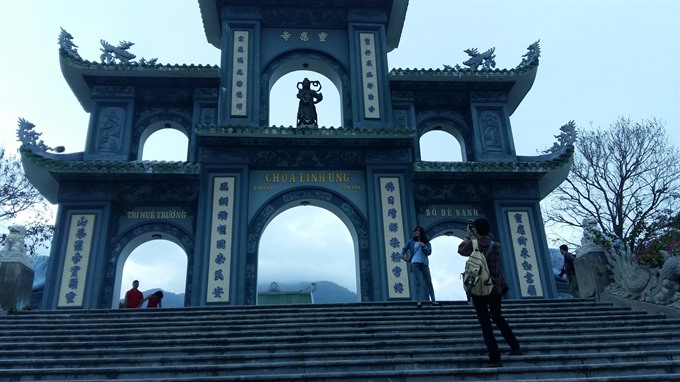 |
| Elaborate: A gate of Linh Ứng Pagoda on Sơn Trà Mountain. — VNS Photo Công Thành |
Cultural confluence
Writer Thái Bá Lợi, 72, said Đà Nẵng carries a mixture of Đại Việt, Champa and pre-Sa Huỳnh cultures.
“Đà Nẵng and Quảng Nam were built on the foundation of the pre-Sa Huỳnh Culture (3,000 BC), and then the Champa Kingdom (between the fourth and 13th centuries). Đà Nẵng was a favourite settlement for fishermen and people from coastal Thanh Hóa and Nghệ An provinces in their southward move under the reign of King Lê Thánh Tông,” Lợi said.
Lợi’s 400-page novel, Minh Sư (the Mastermind), which was written between 2004-2009, was awarded the Southeast Asian Writers Award by the Thai Royal Family in 2013. His novel describes the life of Lord Nguyễn Hoàng (1525 - 1613) who expanded the nation southwards in the 16th century. The southward movement eventually spanned two centuries under the oversight of 13 kings and nine lords.
Lợi was born in 1945 in Quỳnh Lưu District of Nghệ An Province. He joined the Việt Nam People’s Army during the anti-American war in 1971 and settled in Đà Nẵng after the 1975 reunification.
The American War was only a continuation of the strategic significance that Đà Nẵng has had for centuries. It was the first Vietnamese defence site the French-Spanish coalition forces attacked in 1858-1860, starting a century-long colonial rule of the French in Việt Nam. Đà Nẵng was called Tourane Villa during the French colonial period.
Thus the city has always been a "crucial location for Việt Nam in terms of economy, defence and international trade with its deep sea port, road and railway,” Lợi said.
Building bridges
The separation from former Quảng Nam-Đà Nẵng to become one of five key cities under the central government allowed Da Nang to enter the most impressive development phase yet in its long history, using its strategic location to good effect.
At the heart of Da Nang’s unprecedented urbanization push are nine bridges built over the Hàn River to connect the city’s downtown and beach tourism destinations in Sơn Trà and Ngũ Hành Sơn districts; as well as the UNESCO-recognised Hội An Town in Quảng Nam Province.
The connectivity afforded by the bridges were further cemented by an extensive infrastructure upgrade that saw the city grow from only 360 streets in 1997 to more than 2,000 now.
Thousands of slums on the east side of the Hàn River bank were cleared for community space and entertainment, and homeless fishermen were resettled in apartments.
A vast, pristine beach, once used by fishing boats in Sơn Trà and Thanh Khê districts to dock at night, has now become a major tourist attraction.
In the last 20 years, the number of beach resorts and hotels has increased from 61 to nearly 600, and its accommodation capacity soared to 5.6 million tourists – 27 times as many as in 1997.
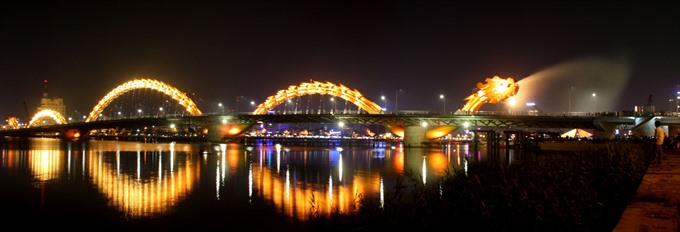 |
| Old but new: The Rồng (Dragon) Bridge connects the city’s downtown and beach tourism sites of Sơn Trà Peninsula. — VNS Photos Trần Lê Lâm |
The Five‘Nos’
The city was the first urban area in Việt Nam to comprehensively carry out the Five Nos programme: no poverty or starvation; no illiteracy; no beggars; no drug users; and no murder and robbery.
The success of this campaign has contributed in no small measure to making the city the country’s most popular place to live in, and the resultant infrastructure construction boom has significantly boosted employment.
More than 3,300 apartments were built from 2008 to 2015, while 34,000 jobs were created, helping keep unemployment down to 4.9 per cent.
Core sectors
The city’s master development plan for 2030 - 2050 focuses on tourism, hi-tech industry and hi-tech agriculture, particularly for organic farming as core sectors.
The Asia institute of City Management (AiCM), which had commissioned a year-long study on Đà Nẵng, announced last year that the coastal city is the most liveable place in Việt Nam.
Unlike the larger cities of Hà Nội and Hồ Chí Minh City, which have much older infrastructure, Đà Nẵng has reaped the advantage of starting afresh, according to the institute.
It plans to become a ‘smart and green’ city by 2030.
In 2013, the city became the first locality in the country to use Facebook for inviting public feedback. The Facebook page of the city’s urban management agency, which has nearly 17,000 members, invites and collects opinions from locals and tourists on environmental pollution and related violations.
The city’s Information and Communications Department says they have put 1,196 administrative procedures online, as 95 per cent of public employees are computer savvy now.
In 2014, Đà Nẵng took the application of e-government systems to a new level, installing a Metropolitan Area Network (MAN), wireless internet, data centre and a centre for human training and research on Information Technology (IT) applications.
In 2015, one-stop shops were introduced along with free wireless internet (wifi) services. The city aims to become a centre of hi-tech industries, tourism and service, an ASEAN logistics hub and a key dynamic city for development in the central region.
Welfare provider
Amidst its urbanisation drive, the city has also paid attention to marginalised sections of the society. More than 1,500 homeless people are being taken care of at social care centres, and 14,500 underprivileged people have been allocated accommodations and given financial support.
The city has also built more than 7,700 apartments for low-income residents and several hostels have been built to accommodate 6,000 students.
Đà Nẵng is the first city in Việt Nam to launch a non-profit hospital for cancer patients. The hospital operates with funding from the city budget and donations from businesses, individuals and NGOs. It provides free treatment for the poor, while costs for paying cancer patients are close to 25 per cent less than State-owned hospitals.
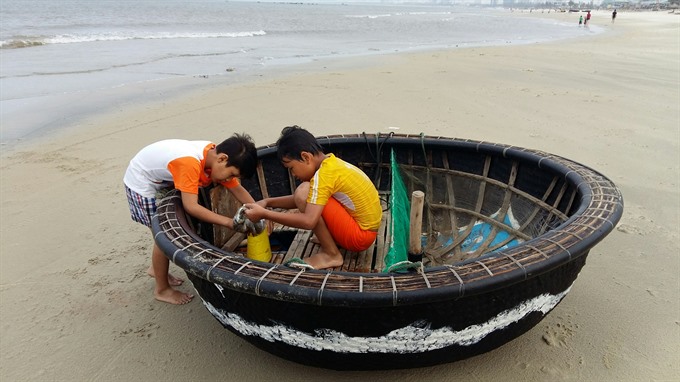 |
| Spin out: Kids play in a coracle on the beach in Đà Nẵng. — VNS Photo Công Thành |
Special feeling
Tourist Đào Hải, who spent four days in the city, is one of many who’ve been made to feel most welcome by the locals.
“I can sit for a morning coffee in a pavement caf and easily make friends with local residents. I always get reasonable suggestions about the city’s landmarks, restaurants and other places from local people,” he said.
"I wish to come back here on my next trip. Cheap and fresh seafood, the beautiful beaches and pagodas, interesting craft works and friendly people make this city one my favourite places.”
Among several unique attractions in Đà Nẵng is the annual International Fireworks Competition that has been held on the banks of the Han River since 2008. It has become a landmark event and a rendezvous for famous firework teams from all over the world.
The 4,439ha Sơn Trà Nature Reserve, home to about 1,300 endangered red-shanked douc langurs (Pygathrix nemaeus) that are only found in Việt Nam and Laos, add to Đà Nẵng’s natural allure. The reserve, just 10km from downtown Đà Nẵng, is home to more than 1,000 plants and 370 animal species.
 |
| Desirable: Coastal Võ Nguyên Giáp Street is one of the most beautiful roads in Đà Nẵng. It runs along Đà Nẵng beach and Sơn Trà Mountain. — VNS Photos Trần Lê Lâm |
APEC boost
Nguyễn Thị Hoài An, vice director of the city’s tourism promotion centre, said hosting the 2017 APEC Summit was an honour for Đà Nẵng and Việt Nam, and a “golden opportunity” to promote the city’s attractions worldwide.
“APEC will be a really good chance for Đà Nẵng to introduce its potential as a destination for beach tourism, luxury resorts, and a favoured MICE (Meeting, Incentives, Conference and Exhibition) site,” An said.
“Local enterprises can meet with businesses from the group’s 21 member economies and seek partnerships, contributing to the development of all sectors,” she said.
Home at last
Amidst all the APEC-related buzz, painter Thuấn is at peace. He has found many friends in Đà Nẵng, and his gallery has become a loving space for artists, painters and young, creative people.
“The Hàn River soothes me. I always wake up and whisper my love for it. The city and people treat me gently, and my art will be my special gift to the city, its beaches, its rivers and mountains.
"For most people, their motherland is the final destination.
It has been a long journey for me. I eventually returned to my home country to relive my childhood and meet friends. I was tired of travelling around the world.
“Đà Nẵng is my last destination." – VNS
| Đà Nẵng city is located in central Việt Nam, neighbouring with Thừa Thiên-Huế to the North; Quảng Nam Province to the West and South, while facing the East Sea to the East. The city covers an area of 1,255sq.km and has a population of 900,000. It is about 800km south of Hà Nội and is cited as an entrance to four World Heritage areas including the former royal capital city of Huế, Hội An ancient town and Mỹ Sơn Sanctuary in Quảng Nam and UNESCO-recognised Phong Nha-Kẻ Bàng in Quảng Bình Province. The city has two seasons: the rainy season from August to December and the dry season last January to July. It has a total of 90km of coastline and dozens of beaches, of which Mỹ Khê on Sơn Trà peninsula, is well-known as one of six most beautiful beaches in the world. The city’s Ngũ Hành Sơn District is well-known as a centre for stone art. The Non Nước stone craft village stands at the foot of the Ngũ Hành Sơn (Marble Mountain). |
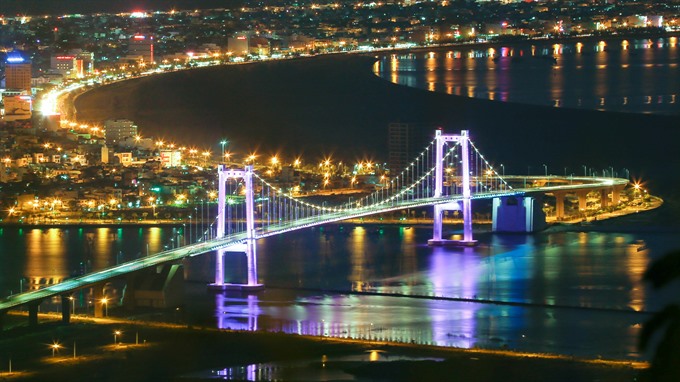 |
| Special: Thuận Phước Bridge features architecture similar to that in San Francisco. — VNS Photos Trần Lê Lâm |




